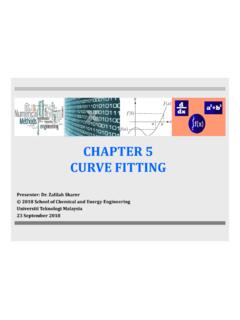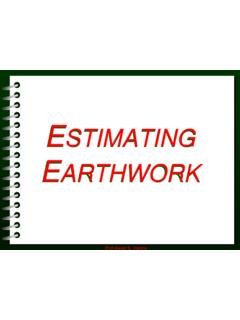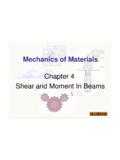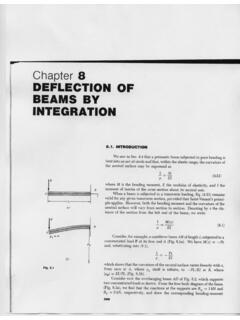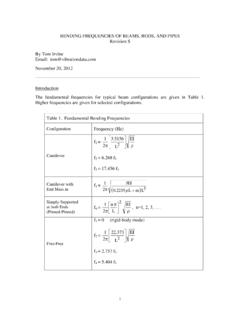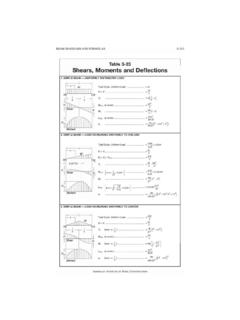Transcription of CHAPTER 2 Shear Force And Bending Moment
1 CHAPTER 2. Shear Force And Bending Moment INTRODUCTION. Effects Action Loading Shear Force Design Shear reinforcement Loading Bending Moment Design flexure reinforcement SKAA SKAA. 2223 3353. Shear Force & Bending Moment . Introduction - Types of beams - Effects of loading on beams - The Force that cause shearing is known as Shear Force - The Force that results in Bending is known as Bending Moment - Draw the Shear Force and Bending Moment diagrams Shear Force & Bending Moment . Members with support loadings applied perpendicular to their longitudinal axis are called beams.
2 Beams classified according to the way they are supported. TYPES OF SUPPORT. As a general rule, if a support prevents translation of a body in a given direction, then a Force is developed on the body in the opposite direction. Similarly, if rotation is prevented, a couple Moment is exerted on the body. Shear Force & Bending Moment . Types of beam a) Determinate beam The Force and Moment of reactions at supports can be determined by using the 3 equilibrium equations of statics Fx= 0, Fy= 0 and M = 0. b) Indeterminate beam The Force and Moment of reactions at supports are more than the number of equilibrium equations of statics.
3 (The extra reactions are called redundant and represent the amount of degrees of indeterminacy). Shear Force & Bending Moment . In order to properly design a beam , it is important to know the variation of the Shear and Moment along its axis in order to find the points where these values are a maximum. PRINCIPLE OF MOMENTS. The Moment of a Force indicates the tendency of a body to turn about an axis passing through a specific point O. The principle of moments, which is sometimes referred to as Varignon's Theorem (Varignon, 1654 . 1722) states that the Moment of a Force about a point is equal to the sum of the moments of the Force 's components about the point.
4 PRINCIPLE OF MOMENTS. In the 2-D case, the magnitude of the Moment is: Mo = Force x distance beam 'S REACTION. If a support prevents translation of a body in a particular direction, then the support exerts a Force on the body in that direction. Determined using Fx = 0, Fy = 0 and M = 0. EXAMPLE 1. The beam shown below is supported by a pin at A and roller at B. Calculate the reactions at both supports due to the loading. 20 kN 40 kN. A B. 2m 3m 4m EXAMPLE 1 Solution Draw the free body diagram: 20 kN 40 kN. RAx A B. 2m 3m 4m RAy RBy By taking the Moment at B, MB = 0 Fy = 0 Fx = 0.
5 RAy 9 20 7 40 4 = 0 RAy + RBy 20 40 = 0 RAx = 0. 9 RAy = 140 + 160 RBy = 20 + 40 RAy = kN RBy = kN. EXAMPLE 2. Determine the reactions at support A and B for the overhanging beam subjected to the loading as shown. 15 kN/m 20 kN. A B. 4m 3m 2m EXAMPLE 2 Solution Draw the free body diagram: 15 kN/m 20 kN. RAx A. B. 4m 3m 2m RAy RBy By taking the Moment at A: MA = 0 Fy = 0 Fx = 0. RBy 7 + 20 9 (15 3) = 0 RAy + RBy 20 45 = 0 RAx = 0. 7 RBy = + 180 RAy = 20 + 45 RBy = kN RAy = kN. CLASS EXERCISE 5 mins? 40 kN 12 kN/m 2 5 kN/m 50 kNm A B. 2m 6m 2m EXAMPLE 3. A cantilever beam is loaded as shown.
6 Determine all reactions at support A. 20 kN. 5 kN/m 3 15 kNm 4. A. 2m 2m 1m EXAMPLE 3 Solution Draw the free body diagram: MA 20 kN. 5 kN/m 3 15 kNm RAx 4. A Fx = 0. RAy 2m 2m 1m RAx + 20 (4/5) = 0. RAx = 16 kN. Fy = 0 MA = 0. RAy (5)(2) 20(3/5) = 0 MA + (5)(2)(1/3)(2) + 20(3/5) (4) + 15 = 0. RAy 5 12 = 0 MA = + 48 + 15. RAy = 17 kN MA = kNm Shear Force & Bending . Moment DIAGRAM. a P. x RA a RB. M. V. RA P. M. V. RB. Shear Force & Bending . Moment DIAGRAM. V= Shear Force = the Force that tends to separate the member = balances the reaction RA. M = Bending Moment = the reaction Moment at a particular point (section).
7 = balances the Moment , RA x Shear Force & Bending . Moment DIAGRAM. From the equilibrium equations of statics: + Fy = 0; RA V = 0 V = RA. + Ma-a = 0; M + RA x = 0 M = RA x Shear Force & Bending . Moment DIAGRAM. P F Q. a a Ra Rb P F Fy = 0. a Ra P F V = 0. M V = Ra P F. a x1 V Ma-a = 0. x2. Ra M F x1 P x2 + Ra x3 = 0. x3. M = Ra x3 F x1 P x2. Shear Force & Bending . Moment DIAGRAM. Shape deformation due to Shear Force : V V V. + V. V. V V V +. Shear Force & Bending . Moment DIAGRAM. Shape deformation due to Bending Moment : M M. +. M M . Sign Convention: Positive Shear Force diagram drawn ABOVE the beam Positive Bending Moment diagram drawn BELOW the beam EXAMPLE 4.
8 A) Calculate the Shear Force and Bending Moment for the beam subjected to a concentrated load as shown in the figure. Then, draw the Shear Force diagram (SFD) and Bending Moment diagram (BMD). b) If P = 20 kN and L = 6 m, draw the SFD and BMD for the beam . P kN. A B. L/2 L/2. EXAMPLE 4 Solution a) P kN. RAx L/2 L/2. RAy RBy By taking the Moment at A: Fy = 0 Fx = 0. MA = 0 RAy + RBy = P RAx = 0. RBy L + P L/2 = 0 RAy = P P/2. RBy = P/2 kN RAy = P/2 kN. EXAMPLE 4 Solution P kN. L/2 L/2. P/2 P/2. Between 0 x L/2: Fy = 0, V + P/2 = 0. x M. V = P/2 kN. P/2 V. Ma-a = 0, M + Px/2 = 0.
9 M = Px/2 kNm If x = 0 m, V = P/2 kN and M = 0 kNm If x = L/2 m, V = P/2 kN and M = PL/4 kNm EXAMPLE 4 Solution P kN. L/2 L/2. P/2 P/2. Between L/2 x L: P kN. Fy = 0, V + P/2 P = 0. V = P/2 kN L/2 M. x V. Ma-a = 0, M + Px/2 P(x L/2) = 0 P/2. M = PL/2 Px/2 kNm If x = L/2 m, V = P/2 kN and M = PL/4 kNm If x = L m, V = P/2 kN and M = 0 kNm EXAMPLE 4 Solution P kN. A B. P/2 L/2 L/2 P/2. P/2 P/2. (+). SFD A B. (-). P/2 P/2. BMD 0 0. (+). PL / 4. EXAMPLE 4 Solution 20 kN. b). A B. 10 kN 3m 3m 10 kN. 10 10. (+). SFD (kN) A B. (-). 10 10. BMD (kNm) 0 0. (+). 30. EXAMPLE 5.
10 Calculate the Shear Force and Bending Moment for the beam subjected to a concentrated load as shown in the figure, then draw the Shear Force diagram (SFD) and Bending Moment diagram (BMD). 15 kN. A B. 3m 2m EXAMPLE 5 Solution 15 kN. A B. RAx 3m 2m RAy RBy By taking the Moment at A: Fy = 0 Fx = 0. MA = 0 RAy + RBy = 15 RAx = 0. RBy 5 + 15 3 = 0 RAy = 15 9. RBy = 9 kN RAy = 6 kN. EXAMPLE 5 Solution 15 kN. A B. 3m 2m 6 kN 9 kN. 6 6. A (+) B. SFD (kN). (-). 9 9. BMD (kNm) 0 0. (+). 18. EXAMPLE 6. Calculate the Shear Force and Bending Moment for the beam subjected to an uniformly distributed load as shown in the figure, then draw the Shear Force diagram (SFD) and Bending Moment diagram (BMD).




